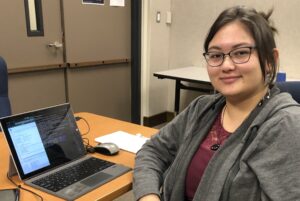
Catherine is from Hilo, born and raised, homeschooled until 16, then began attending HCC as a dual-credit enrollment student, transferred to UH at 17. She has been working on a Bachelors of Computer Science at University of Hawaii at Hilo since, aiming to graduate in Spring of 2024. If she’s able to find a suitable job, she’d like to go for her master’s in CS, but doesn’t have much interest in anything further except for teaching purposes. She can usually be found in the computer lab working on homework or playing games, and a good book will hold her attention for hours.
Home Island: Big Island, Hawaii
High School:
Institution when accepted: University of Hawaii at Hilo
Akamai Project: Decoding Ground-level Chaos: Exploring Meteorological, Environmental, and AIRFLOW Data to Identify Key Causes of Ground-level Optical Turbulence
Project Site: UH Institute for Astronomy, Hilo, HI
Mentors: Mark Chun & Luke McKay
Project Abstract:
Image quality of ground-based telescopes such as the University of Hawaii 2.2-meter telescope (UH 2.2m) is hindered by optical turbulence, much like how heat haze on a road distorts one’s view. This type of turbulence is caused by mechanical energy in conjunction with temperature variations. This project took the first step in quantifying the effects of environmental conditions on optical turbulence inside the dome of the UH 2.2m. We used AIRFLOW (Airborne Interferometric Recombiner – Fluctuations of Light at Optical Wavelengths) sensors to sample optical turbulence at various locations within the dome by projecting a light pattern across a distance of 100 mm. The aim of this project is to use this sensor data, along with meteorological data from the summit weather station, and dome environment data from the engineering databases to perform a preliminary analysis aimed at identifying key problems and significant contributors to the dome’s optical turbulence. Since our AIRFLOW sensors record data every 5 minutes, while the meteorological data is recorded every minute, the first stage of this work involved the creation and synchronization of the datasets from each of the relevant sources. The second stage focused on analyzing the data for major factors within the resulting datasets. This data will help determine new locations for the sensors, which will be moved at some point to monitor areas of more interest as indicated by the initial analysis. The data from the new locations will also be incorporated into the analysis as additional datasets.